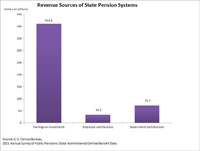end of header
Newsroom Archive
Release Information
Contact: Brian Lavin
Public Information Office
301-763-3030
FOR IMMEDIATE RELEASE: THURSDAY, AUG. 9, 2012
Census Bureau Reports State Pension Systems Assets Rise Nearly $325 Billion in 2011

The nation’s state-administered defined benefit retirement systems totaled $2.5 trillion in cash and investment holdings in 2011, a 14.6 percent increase from $2.2 trillion in 2010, according to new statistics from the U.S. Census Bureau. Earnings on investments were $410.6 billion, up from $291.1 billion in 2010. (See Table 1.)
These statistics come from the 2011 Annual Survey of Public Pensions: State-Administered Defined Benefit Data, which provides an annual look at the financial activity and membership information for the nation’s 222 state-administered public-employee retirement systems, including revenues, expenditures, investment holdings, membership and beneficiaries. Statistics are shown for the nation and individual states. This information includes actuarial liability statistics, which project the total obligation required to cover costs for providing pensions to former and present employees.
Cash and Security Investment Holdings
Corporate stocks increased 13.8 percent, from $767.1 billion in 2010 to $873.2 billion in 2011 (and comprised 34.3 percent of total holdings in 2011). Corporate bonds decreased 2.1 percent, from $357.0 billion in 2010 to $349.7 billion in 2011 (and comprised 13.8 percent of total holdings in 2011).
Among the cash and security holdings for public pensions, foreign and international securities increased 24.1 percent, from $359.4 billion in 2010 to $446.0 billion in 2011 (and comprised 17.5 percent of total holdings in 2011). Federal government securities increased 7.4 percent, from $192.3 billion in 2010 to $206.6 billion in 2011 (and comprised 8.1 percent of total holdings in 2011).
Cash and short-term investments increased 36.4 percent, from $78.7 billion to $107.3 billion (and comprised 4.2 percent of total holdings in 2011). Real property increased 28.6 percent, from $83.3 billion in 2010 to $107.1 billion in 2011 (and comprised 4.2 percent of total holdings in 2011).
Nongovernmental securities (e.g., corporate stocks and bonds, foreign and international securities, funds held in trust, and mortgages) were $1.8 trillion in 2011, a 12.1 percent increase from 2010. Nongovernmental securities comprised 72.0 percent of total cash and security holdings. (See Table 4 for individual state statistics.)
Receipts
Total revenue increased 32.8 percent, from $389.0 billion in 2010 to $516.5 billion in 2011. The increase was driven by the rise of earnings on investments, which showed gains of $410.6 billion in 2011. Earnings on investments comprised 79.5 percent of total revenue, government contributions comprised 13.9 percent, and employee contributions accounted for the remaining 6.6 percent of total revenue in 2011. (See Figure 1.) Government contributions increased 10.7 percent, from $64.8 billion in 2010 to $71.7 billion in 2011. Employee contributions increased 3.0 percent, from $33.2 billion in 2010 to $34.2 billion in 2011. (See Table 2 for individual state statistics.)
Payments
Covered payroll — payments made to active employees on which contributions to a pension plan are based — increased 0.3 percent from $596.2 billion in 2010 to $598.0 billion in 2011. Pension obligations increased 3.7 percent, from $3.3 trillion in 2010 to $3.4 trillion in 2011. (See Table 6 for individual state statistics.)
Total payments increased 8.5 percent, from $174.2 billion in 2010 to $189.0 billion in 2011. The increase in total payments was driven by an increase in benefit payments, which comprised 93.6 percent of total payments in 2011. Benefit payments increased 8.2 percent, from $163.4 billion in 2010 to $176.8 billion in 2011. (See Table 3 for individual state statistics.)
Statistics are shown for individual retirement systems and for aggregate national and state levels. The structure of retirement systems varies widely among states. In some jurisdictions, state and local government employees are vested in a small number of statewide systems.
The Internet tables are from the Annual Survey of Public Pensions: State-Administered Defined Benefit Data for fiscal year 2011. The statistics in these tables are from all state-administered public-employee defined benefit retirement systems and as such are not subject to sampling variability. The statistics are subject to coverage, response, and processing errors, as well as errors of nonresponse. For more information on the data limitations, definitions, and methodology, see <https://www.census.gov/govs/retire/state_how_data_collected.html>.
For more information on realized and unrealized gains/losses, see Section 7.2.2, Measurement Issues: Valuation, of the 2006 Government Finance and Employment Classification Manual at <https://www.census.gov/govs/classification/>.
Comments or suggestions?




